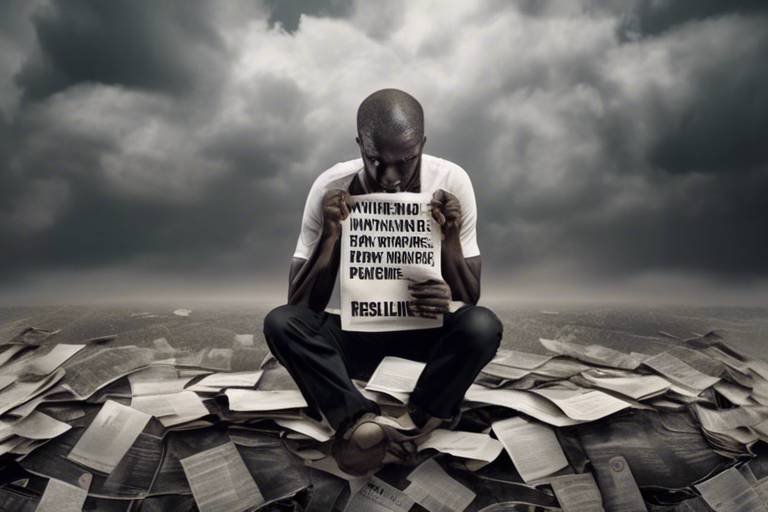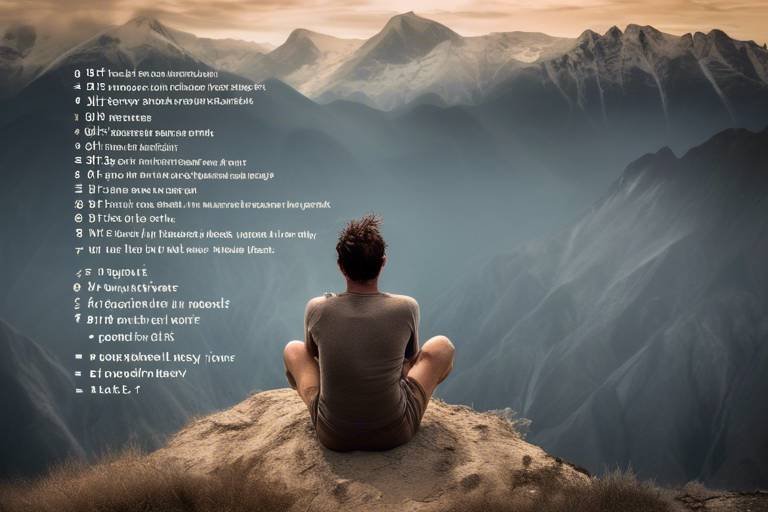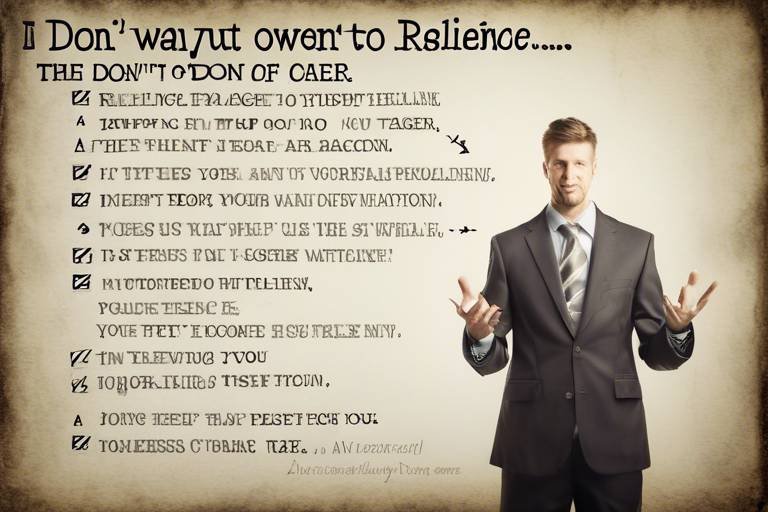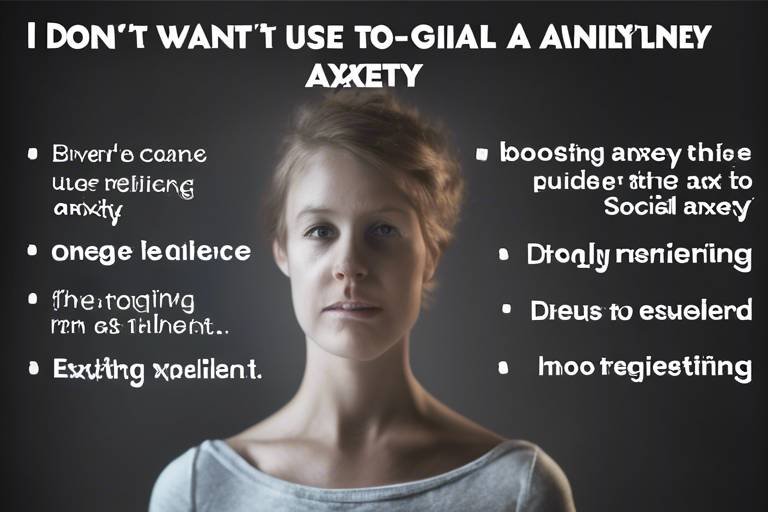Building Resilience for Managing PTSD - Essential Tips
Post-Traumatic Stress Disorder (PTSD) can feel like a heavy backpack filled with rocks—each traumatic experience adding another stone, making it harder to move forward. But just like any weight can be lifted, resilience can help individuals manage and even lighten this load. In this article, we’ll explore effective strategies to build that resilience, enabling those coping with PTSD to regain control over their lives and emotions. Whether you’re looking for practical tips or deeper insights, you’re in the right place!
PTSD is a mental health condition triggered by experiencing or witnessing a traumatic event. It’s not just a fleeting feeling of sadness or anxiety; it manifests through various symptoms such as flashbacks, nightmares, and severe anxiety. Imagine being trapped in a loop of distressing memories that keep replaying in your mind—this is the daily reality for many individuals with PTSD. Recognizing the symptoms is crucial because it paves the way for understanding the importance of building resilience. Resilience acts like a mental shield, helping individuals navigate the stormy seas of trauma and emerge stronger on the other side.
Resilience is more than just bouncing back; it’s about thriving despite adversity. Think of it as a rubber band: it stretches under pressure but snaps back into shape. For those dealing with PTSD, resilience provides the emotional strength needed to face challenges head-on. It helps individuals maintain their emotional stability, allowing them to process their experiences without being overwhelmed. This protective factor can be the difference between stagnation and growth, making it essential for anyone on the healing journey.
Several factors contribute to an individual’s resilience. These include:
- Personality Traits: Characteristics like optimism and adaptability can significantly enhance resilience.
- Social Support: Having a network of friends, family, or support groups can provide emotional backing during tough times.
- Coping Mechanisms: Effective strategies for dealing with stress can bolster resilience.
By recognizing and cultivating these factors, individuals can strengthen their ability to cope with PTSD and its challenges. It’s like building a muscle: the more you work on it, the stronger it gets!
Creating a strong support system is vital. Think of your support network as a safety net; it catches you when you fall and helps you rise again. This network can include:
- Friends and Family: Those who know you best can offer unconditional love and understanding.
- Support Groups: Connecting with others who share similar experiences can provide validation and encouragement.
Building these connections can significantly enhance resilience, providing a sense of belonging and emotional assistance that is crucial in the healing process.
Practical coping strategies can be game-changers for individuals managing PTSD. Techniques like mindfulness, journaling, and engaging in physical activity can help mitigate symptoms and build resilience. For instance, mindfulness encourages individuals to stay present, reducing the grip of past traumas. Journaling offers a safe space to express feelings, while physical activity releases endorphins—nature’s mood boosters. Incorporating these strategies into daily routines can create a solid foundation for emotional well-being.
Various therapeutic methods can promote resilience in PTSD treatment. Cognitive-behavioral therapy (CBT) helps individuals reframe negative thoughts, while Eye Movement Desensitization and Reprocessing (EMDR) can assist in processing traumatic memories. Other evidence-based practices also play a significant role in recovery. It’s essential to find the right approach that resonates with you, as this can lead to profound changes in how you handle trauma.
Self-care is not just a buzzword; it’s a crucial component in building resilience. Healthy lifestyle choices, relaxation techniques, and maintaining a balanced routine can make a world of difference. Think of self-care as the fuel for your emotional engine. Without it, you risk running on empty. Simple practices like getting enough sleep, eating nutritious meals, and engaging in hobbies can rejuvenate your mind and body, making you more resilient against the challenges of PTSD.
Mindfulness and meditation are powerful tools for enhancing emotional regulation and resilience. These practices provide individuals with techniques to manage their PTSD symptoms effectively. By focusing on the present moment, individuals can create a buffer against the intrusive thoughts and feelings that often accompany PTSD. Just like a calm lake reflects the sky, mindfulness helps clear the mental clutter, allowing for a more peaceful state of being.
Setting achievable goals can foster resilience by providing a sense of purpose and accomplishment. Whether it’s a small daily objective or a larger life goal, having something to strive for can motivate individuals to keep moving forward. Think of it as planting seeds in a garden; with care and attention, those seeds can blossom into beautiful flowers of achievement, reminding you of your strength and capability.
Q: What is PTSD?
A: PTSD is a mental health condition triggered by experiencing or witnessing a traumatic event, leading to symptoms like flashbacks, nightmares, and severe anxiety.
Q: How does resilience help in managing PTSD?
A: Resilience acts as a protective factor, enabling individuals to bounce back from traumatic experiences and maintain emotional stability.
Q: What are some effective coping strategies for PTSD?
A: Effective strategies include mindfulness, journaling, physical activity, and building a strong support network.
Q: Can therapy help with building resilience?
A: Yes, therapeutic approaches like cognitive-behavioral therapy and EMDR can significantly promote resilience in individuals with PTSD.
Q: Why is self-care important for resilience?
A: Self-care practices help recharge your emotional and physical well-being, making it easier to cope with the challenges of PTSD.

Understanding PTSD
Post-Traumatic Stress Disorder, commonly known as PTSD, is a mental health condition that can occur after experiencing or witnessing a traumatic event. It's not just a case of feeling a little shaken up; for many, it can feel like living in a constant state of fear and anxiety. Imagine waking up every day with a sense of dread, as if the traumatic experience is haunting you. Symptoms of PTSD can vary widely, but they often include flashbacks, nightmares, severe anxiety, and uncontrollable thoughts about the event. This can make daily life feel overwhelming and isolating.
Understanding PTSD is crucial, not only for those who suffer from it but also for their loved ones. The effects can ripple through relationships, work, and social interactions. It's like a shadow that looms over every aspect of life, making it essential to address it head-on. The importance of resilience in this context cannot be overstated. Resilience acts as a buffer against the debilitating symptoms of PTSD, allowing individuals to navigate their emotions and experiences more effectively.
To give you a clearer picture, here are some common symptoms associated with PTSD:
- Re-experiencing the trauma: This can manifest as flashbacks or intrusive thoughts that bring the traumatic event back to life.
- Avoidance: Individuals may avoid places, people, or activities that remind them of the trauma.
- Negative changes in thinking and mood: This can include feelings of hopelessness, detachment from others, and difficulty experiencing positive emotions.
- Heightened arousal: Symptoms like irritability, difficulty sleeping, and being easily startled are common.
It's important to recognize that PTSD doesn't affect everyone the same way. Some may experience symptoms immediately after the trauma, while others might not show signs until months or even years later. This variability can lead to misunderstandings and stigma, making it all the more vital to foster a supportive environment for those dealing with PTSD.
In summary, understanding PTSD involves recognizing its symptoms and the profound impact it can have on an individual's life. By building resilience, individuals can take significant steps toward healing and reclaiming their sense of self. The journey may be challenging, but with the right support and strategies, it is entirely possible to navigate through the darkness and emerge stronger.

The Role of Resilience
Resilience plays a crucial role in managing Post-Traumatic Stress Disorder (PTSD). It acts as a mental shield, allowing individuals to navigate through the emotional turmoil that often accompanies traumatic experiences. Just like a rubber band that stretches but snaps back into shape, resilience enables people to bounce back from adversity. It’s not about avoiding stress or trauma; rather, it’s about how one responds to it. When faced with challenges, resilient individuals are more likely to maintain their emotional stability and find ways to cope effectively.
Think of resilience as a muscle. The more you work it out, the stronger it becomes. This strength is essential in the healing process for those dealing with PTSD. It allows individuals to confront their fears, process their emotions, and gradually reclaim their lives. Resilience doesn't mean that a person won't experience difficulty; it means they have the tools and mindset to manage those difficulties without becoming overwhelmed. This can be particularly important when dealing with symptoms such as anxiety, flashbacks, and emotional numbness.
Moreover, resilience is not a one-size-fits-all trait; it is influenced by various factors. These can include:
- Personality Traits: Certain traits, such as optimism and adaptability, can enhance resilience.
- Social Support: A strong network of friends, family, and peers provides emotional backing and practical assistance.
- Coping Mechanisms: Healthy coping strategies, like mindfulness and problem-solving, bolster resilience.
By recognizing and nurturing these factors, individuals can cultivate a greater sense of resilience. This is particularly significant for those dealing with PTSD, as it empowers them to take control of their healing journey. It’s about building a foundation that can withstand the storms of life while still allowing for growth and recovery.
In essence, resilience is a dynamic process that involves personal growth and the ability to adapt to life's challenges. It is not merely about enduring hardship; it’s about thriving in spite of it. As individuals learn to harness their resilience, they can transform their relationship with trauma, ultimately leading to a more fulfilling and empowered life.

Factors Influencing Resilience
When it comes to building resilience in the face of PTSD, several factors play a crucial role. Think of resilience as a muscle; the stronger the muscle, the better it can withstand stress and trauma. But what exactly contributes to this strength? Let's dive into some of the key elements that influence resilience.
First and foremost, personality traits are significant. Individuals who tend to be optimistic or have a growth mindset often find it easier to bounce back from adversity. They view challenges as opportunities for growth rather than insurmountable obstacles. This perspective can make a world of difference when dealing with the aftermath of trauma.
Another essential factor is social support. Having a robust network of friends, family, or even support groups can act as a safety net during tough times. Imagine trying to climb a mountain alone; it’s daunting and exhausting. But with a team by your side, the journey becomes more manageable. Social connections provide emotional assistance, practical help, and a sense of belonging that can significantly enhance resilience.
Moreover, the way we cope with stress also influences our resilience. Coping mechanisms can be categorized into two main types: adaptive and maladaptive. Adaptive strategies, such as seeking help, engaging in physical activity, or practicing mindfulness, can bolster resilience. In contrast, maladaptive strategies, like substance abuse or avoidance, can weaken it. It’s crucial to cultivate healthy coping mechanisms to foster resilience effectively.
Additionally, past experiences play a pivotal role. Those who have successfully navigated previous challenges often develop a sense of mastery and confidence in their ability to handle future difficulties. This sense of achievement can act as a springboard, propelling individuals forward when faced with new adversities.
Lastly, environmental factors such as socioeconomic status, access to resources, and community support can also shape resilience. A supportive environment can provide the tools and opportunities necessary for individuals to thrive despite their circumstances. For instance, communities that prioritize mental health resources create a fertile ground for resilience to flourish.
In summary, building resilience is a multifaceted process influenced by various factors, including personality traits, social support, coping mechanisms, past experiences, and environmental conditions. By understanding these elements, individuals can take proactive steps to enhance their resilience and better manage the challenges posed by PTSD.

Building a Support Network
Building a strong support network is not just a nice-to-have; it's a crucial lifeline for individuals grappling with PTSD. Think of your support network as a safety net, one that can catch you when you fall and help you regain your balance. Friends, family, and support groups play a vital role in this journey towards healing. They provide not only emotional support but also practical assistance that can make a world of difference during tough times.
First off, it's essential to recognize that not everyone will understand what you're going through, and that's okay. The key is to surround yourself with people who are empathetic and willing to listen. This doesn’t mean you need to share your story with everyone; instead, focus on building relationships with those who respect your boundaries and offer a comforting presence. Consider reaching out to friends who have shown patience and understanding in the past. These individuals can become your go-to allies when you need someone to talk to or lean on.
Moreover, support groups can be incredibly beneficial. They offer a unique environment where you can connect with others who share similar experiences. This sense of community can alleviate feelings of isolation, reminding you that you are not alone in your struggles. In these groups, you can share coping strategies, learn from others, and even find inspiration in their journeys. Many find that hearing others' stories helps to normalize their own experiences, making the healing process feel more achievable.
It's also important to keep in mind that building a support network takes time and effort. Just like planting a garden, you need to nurture these relationships to see them flourish. Here are a few tips to help you cultivate your support network:
- Be Open: Share your feelings and experiences when you feel comfortable. Vulnerability can foster deeper connections.
- Stay Engaged: Regularly check in with your support network. A simple text or call can go a long way in maintaining these relationships.
- Seek Professional Help: Sometimes, a therapist or counselor can be a part of your support network, offering insights and coping strategies that friends and family may not be equipped to provide.
In summary, building a support network is a proactive step toward managing PTSD. By surrounding yourself with understanding individuals and engaging with support groups, you create an environment that promotes healing and resilience. Remember, it’s not about the number of people in your network but the quality of those relationships that truly matters. So, take the time to cultivate meaningful connections and watch as your support network becomes a powerful ally in your journey toward recovery.
Q: How do I find a support group for PTSD?
A: You can start by searching online for local mental health organizations or community centers that offer support groups. Websites like Meetup or Facebook groups can also connect you with others facing similar challenges.
Q: What if my friends and family don’t understand PTSD?
A: It’s common for those who haven’t experienced PTSD to struggle with understanding it. Consider sharing educational resources with them to help bridge the gap. You might also want to seek support from those who have experienced similar situations.
Q: Can I build a support network online?
A: Absolutely! Online forums and social media platforms have many communities dedicated to PTSD support. Just be sure to engage in safe and moderated spaces.

Coping Strategies
Coping with Post-Traumatic Stress Disorder (PTSD) can feel like navigating a turbulent sea without a map. But you don't have to sail these stormy waters alone; there are effective strategies to help you manage your symptoms and build resilience. One of the most empowering aspects of coping with PTSD is discovering what works best for you. It's a personal journey, and while some strategies may resonate more than others, the key is to explore and find your own unique toolkit.
One powerful coping strategy is mindfulness. This practice encourages you to stay present in the moment, allowing you to observe your thoughts and feelings without judgment. It’s like standing on the shore and watching the waves crash, rather than getting swept away by them. Mindfulness can help you regain control over your emotional responses and reduce anxiety. Try setting aside a few minutes each day to practice mindfulness through deep breathing exercises or guided meditations. There are numerous apps and online resources available to help you get started.
Another effective strategy is journaling. Writing down your thoughts and feelings can serve as a powerful outlet for processing your experiences. It’s akin to having a conversation with a trusted friend who always listens without judgment. Journaling not only helps you articulate your feelings but also allows you to track patterns in your emotions and triggers. You might consider setting a regular time each day or week to reflect on your experiences, which can provide insight and clarity.
Physical activity is also a vital component of coping with PTSD. Engaging in regular exercise can release endorphins, the body's natural stress relievers, which can help alleviate symptoms of anxiety and depression. Whether it's a brisk walk in the park, a dance class, or even yoga, find an activity that you enjoy. Remember, the goal is to get your body moving and your heart pumping. It's not just about physical health; it's about nurturing your mental well-being too.
Additionally, consider incorporating social connections into your coping strategies. Building a support network can be incredibly beneficial. Surround yourself with friends and family who understand what you're going through, or seek out support groups where you can share experiences with others facing similar challenges. These connections can provide a sense of belonging and validation, reminding you that you are not alone in your journey.
Lastly, don't underestimate the power of self-compassion. Be gentle with yourself as you navigate the complexities of PTSD. Acknowledge that healing is a process, and it's okay to have setbacks along the way. Treat yourself with the same kindness that you would offer to a friend in need. This shift in perspective can foster resilience and help you embrace your journey with a more positive outlook.
In summary, coping strategies for managing PTSD are as diverse as the individuals who experience it. By exploring mindfulness, journaling, physical activity, social connections, and self-compassion, you can build a robust toolkit that supports your resilience. Remember, it's about finding what resonates with you and creating a personalized approach to healing.
- What is the best coping strategy for PTSD? There is no one-size-fits-all answer; different strategies work for different people. It’s important to try various methods and see what resonates with you.
- How long does it take to see results from coping strategies? Results can vary widely. Some may find relief quickly, while others may take longer. Consistency is key.
- Can I manage PTSD without therapy? While coping strategies can be effective, therapy is often beneficial and can provide additional support and guidance.

Therapeutic Approaches
When it comes to managing PTSD, play a pivotal role in helping individuals regain control over their lives. These methods are not just about treating symptoms; they are about fostering a deeper understanding of oneself and building resilience. Think of therapy as a toolbox where each tool is designed to help you navigate the complexities of trauma. Among the various therapeutic modalities, some have proven particularly effective in promoting resilience.
One of the most well-known approaches is Cognitive Behavioral Therapy (CBT). This method focuses on identifying and changing negative thought patterns that contribute to feelings of distress. Imagine your mind as a garden; with CBT, you learn to pull out the weeds of negative thinking and plant seeds of positive, empowering thoughts instead. This process not only helps in alleviating symptoms but also equips individuals with the skills to tackle future challenges.
Another effective approach is Eye Movement Desensitization and Reprocessing (EMDR). EMDR is like a mental detox for traumatic memories. By using guided eye movements, this therapy helps individuals process and integrate traumatic experiences, significantly reducing their emotional charge. It's as if you're rewiring your brain to respond differently to past traumas, allowing for greater emotional stability and resilience.
In addition to these, exposure therapy is a common method used to help individuals confront their fears in a safe environment. This therapeutic approach gradually exposes individuals to the memories and situations that trigger their PTSD symptoms, allowing them to process these experiences without becoming overwhelmed. Think of it as training a muscle; the more you expose yourself to the fear, the stronger you become at handling it.
Moreover, incorporating mindfulness-based therapies can significantly enhance the effectiveness of traditional approaches. Mindfulness encourages individuals to stay present and engage with their thoughts and feelings without judgment. This practice is akin to watching clouds float by; you acknowledge their presence but don’t let them dictate your emotional state. By integrating mindfulness techniques into therapy, individuals can develop a greater sense of emotional regulation and resilience.
Lastly, it's essential to consider the role of group therapy. Sharing experiences with others who have faced similar challenges can foster a sense of community and belonging. It’s like finding a safe harbor in a stormy sea; the support from peers can be incredibly validating and empowering. Group therapy not only provides emotional support but also offers different perspectives and coping strategies, enhancing overall resilience.
In summary, therapeutic approaches for managing PTSD are diverse and tailored to meet individual needs. Whether through CBT, EMDR, exposure therapy, mindfulness, or group support, each method contributes to building resilience. The journey toward healing is not linear, but with the right therapeutic tools, individuals can navigate their path with greater strength and confidence.
- What is the best therapy for PTSD? The best therapy varies by individual, but Cognitive Behavioral Therapy (CBT) and EMDR are widely recognized as effective options.
- How long does therapy for PTSD typically last? The duration of therapy can vary greatly, often ranging from a few months to several years, depending on individual needs and progress.
- Can I combine different therapeutic approaches? Yes, many individuals find that a combination of therapies, such as CBT and mindfulness practices, can be particularly beneficial.
- Is group therapy effective for PTSD? Absolutely! Group therapy can provide support, understanding, and shared experiences, which can significantly enhance the healing process.

Self-Care Practices
When it comes to building resilience, self-care is not just a buzzword; it’s a necessity. Think of self-care as the foundation of a sturdy house. Without it, everything else may crumble under pressure. Individuals dealing with PTSD often find themselves overwhelmed by emotions and memories that can feel like an unending storm. To weather this storm, adopting effective self-care practices is crucial. These practices not only help in managing symptoms but also empower individuals to regain control over their lives.
One of the simplest yet most effective self-care practices is establishing a healthy routine. This includes regular sleep patterns, balanced meals, and physical activity. Just like a car needs regular maintenance to run smoothly, our bodies and minds require consistent care. Eating nutritious foods can fuel your body, while exercise releases endorphins, the body's natural mood lifters. Even a brisk walk can do wonders for your mental state!
In addition to physical health, relaxation techniques play a vital role in self-care. Techniques like deep breathing, yoga, and progressive muscle relaxation can significantly reduce anxiety levels. Imagine your mind as a crowded room; relaxation techniques help clear out the clutter, allowing for a more peaceful environment. Taking just a few minutes each day to practice these techniques can make a world of difference.
Another critical aspect of self-care is engaging in activities that bring joy. Whether it's painting, gardening, or playing an instrument, these hobbies serve as a form of therapy. They distract the mind from negative thoughts and provide a sense of accomplishment. Moreover, setting aside time for these activities is not selfish; it’s a way to recharge your emotional batteries. Think of it as filling up your gas tank before a long journey.
Furthermore, maintaining social connections is an essential self-care practice. Surrounding yourself with supportive friends and family can create a safety net during tough times. It’s like having a lifebuoy when you’re in deep water. Reach out to loved ones, share your feelings, and don’t hesitate to lean on them when you need support. Joining support groups can also be beneficial, offering a sense of community where individuals can share experiences and coping strategies.
Incorporating mindfulness and meditation into your daily routine can also enhance self-care. These practices teach you to focus on the present moment, reducing anxiety about the past or future. Imagine standing on a beach, feeling the sand beneath your feet and listening to the waves. That’s the essence of mindfulness—being fully present and aware. Regular practice can lead to improved emotional regulation and resilience, helping you manage PTSD symptoms more effectively.
Lastly, it’s crucial to set achievable goals as part of your self-care routine. These goals don’t have to be monumental; even small victories matter. Whether it’s reading a chapter of a book or completing a household chore, accomplishing tasks can provide a sense of purpose and boost your confidence. Think of these goals as stepping stones on your journey toward recovery.
In summary, self-care is a multifaceted approach that includes physical, emotional, and social well-being. By integrating these practices into your life, you’re not just surviving; you’re thriving. Remember, just like a plant needs water and sunlight to grow, your mental health flourishes with consistent self-care. So, take a moment today to reflect on what you can do for yourself. You deserve it!
- What is self-care? Self-care refers to the practices that individuals engage in to maintain and enhance their overall well-being.
- How can I incorporate self-care into my daily routine? Start by setting aside time for activities that you enjoy, maintain a balanced diet, and practice relaxation techniques.
- Is self-care selfish? Absolutely not! Self-care is essential for your mental health and enables you to be more present for others.
- Can self-care help with PTSD symptoms? Yes, engaging in self-care practices can significantly alleviate PTSD symptoms and improve emotional resilience.

Mindfulness and Meditation
Mindfulness and meditation are like the dynamic duo of emotional regulation, especially for those grappling with PTSD. Imagine your mind as a busy highway, filled with thoughts zooming past at breakneck speed. Now, picture mindfulness as a traffic light that helps you pause, breathe, and take stock of what’s happening around you. It’s that simple yet profound practice of being present in the moment, and it can significantly enhance your emotional resilience.
Research shows that practicing mindfulness can lead to a reduction in PTSD symptoms. By focusing on the present, individuals can learn to detach from distressing thoughts and feelings that often accompany traumatic memories. Meditation acts like a mental gym; the more you train your mind, the stronger it becomes at managing stress. It’s not just about sitting in silence; it’s about cultivating a deeper awareness of your thoughts and emotions.
So, how do you get started? Think of mindfulness as a daily practice rather than a one-time event. You can integrate it into your life in various ways:
- Breathing Exercises: Take a few moments each day to focus on your breath. Inhale deeply, hold for a few seconds, and exhale slowly. This simple act can ground you and bring clarity.
- Body Scan: Lie down comfortably and mentally scan your body from head to toe. Notice any tension and consciously relax those areas. This not only helps in releasing physical stress but also promotes a sense of calm.
- Mindful Walking: Go for a walk and pay attention to each step. Feel the ground beneath your feet, notice the sounds around you, and breathe in the fresh air. This practice can transform a mundane activity into a meditative experience.
Incorporating meditation into your routine can be equally beneficial. Start with just a few minutes a day and gradually increase the duration. Apps and online resources can guide you through various techniques, making it easier to stick with it. Whether you prefer guided meditations or silent reflection, the key is consistency.
Mindfulness and meditation also create a safe space for self-reflection. They allow you to observe your thoughts without judgment, fostering a deeper understanding of your emotional landscape. This self-awareness can be a game-changer when it comes to managing PTSD symptoms. By recognizing triggers and patterns, you can develop healthier coping mechanisms.
Moreover, these practices can enhance your emotional resilience by promoting a sense of control over your thoughts and feelings. When life throws challenges your way, mindfulness equips you with tools to respond rather than react impulsively. It’s like having a mental toolbox filled with strategies to navigate tough times.
In conclusion, embracing mindfulness and meditation can significantly bolster your resilience in the face of PTSD. They offer practical, effective ways to manage symptoms, enhance emotional regulation, and cultivate a peaceful mind. So why not give it a try? Just a few minutes each day can lead to profound changes in how you experience life.
Q1: How long should I meditate each day?
A1: Start with just 5-10 minutes a day and gradually increase it as you become more comfortable with the practice.
Q2: Do I need to sit in silence to practice mindfulness?
A2: Not at all! Mindfulness can be practiced in various activities, such as walking, eating, or even during conversations.
Q3: Can mindfulness really help with PTSD symptoms?
A3: Yes, numerous studies have shown that mindfulness can reduce symptoms of PTSD by promoting emotional regulation and self-awareness.
Q4: What if I find it hard to focus during meditation?
A4: It's completely normal! Just gently bring your focus back to your breath or the present moment whenever your mind wanders.

Setting Goals
Setting goals is like charting a course on a map; it gives you direction and purpose, especially when navigating the turbulent waters of PTSD. When individuals set clear and achievable goals, they create a sense of structure in their lives that can be incredibly grounding. Imagine waking up each day with a plan, a tangible target to aim for—this can significantly shift your mindset from feeling lost to feeling empowered.
One of the most effective ways to set goals is to ensure they are S.M.A.R.T.: Specific, Measurable, Achievable, Relevant, and Time-bound. This framework not only helps in clarifying your goals but also in tracking your progress. For example, instead of saying, “I want to feel better,” a S.M.A.R.T. goal would be, “I will practice mindfulness for 10 minutes every day for the next month.” This specificity transforms vague wishes into actionable steps.
Moreover, breaking down larger goals into smaller, manageable tasks can prevent feelings of overwhelm. Think of it like climbing a mountain; you wouldn’t try to leap to the summit in one go. Instead, you’d take it step by step, celebrating each small victory along the way. For instance, if your goal is to reconnect with friends, you might start by sending a text to one friend each week. This gradual approach not only builds resilience but also fosters a sense of accomplishment.
Another key aspect of goal-setting is ensuring that your goals align with your values and personal interests. When you pursue what truly matters to you, it becomes easier to stay motivated, even on tough days. Reflect on what brings you joy or fulfillment, and let these insights guide your goal-setting process. For instance, if you love nature, setting a goal to take a weekly walk in the park can serve as both a self-care practice and a way to connect with your surroundings.
Lastly, it’s essential to remain flexible. Life can throw unexpected challenges your way, and that’s okay! Being adaptable in your goals allows you to pivot when necessary without feeling like you’ve failed. If a particular goal becomes too daunting, reassess and modify it rather than abandoning it altogether. Remember, resilience is about bouncing back, and sometimes that means adjusting your sails rather than changing the destination.
In summary, setting goals is a powerful tool in managing PTSD. By creating clear, achievable objectives, breaking them down into smaller tasks, aligning them with personal values, and maintaining flexibility, you can foster a sense of purpose and control in your life. This not only enhances your emotional well-being but also strengthens your resilience, allowing you to navigate your journey with greater confidence.
- What are S.M.A.R.T. goals? S.M.A.R.T. goals are Specific, Measurable, Achievable, Relevant, and Time-bound objectives that help in setting clear and actionable plans.
- How can I stay motivated to achieve my goals? Staying connected to your personal values and celebrating small victories along the way can help maintain motivation.
- What if I don’t achieve my goals? It’s okay! Resilience involves reassessing and adjusting your goals rather than giving up entirely. Flexibility is key.
- Can setting goals really help with PTSD? Yes! Setting goals provides structure, purpose, and a sense of control, all of which are beneficial for managing PTSD symptoms.
Frequently Asked Questions
- What is PTSD and how does it affect individuals?
Post-Traumatic Stress Disorder (PTSD) is a mental health condition triggered by experiencing or witnessing a traumatic event. Symptoms can include flashbacks, nightmares, severe anxiety, and uncontrollable thoughts about the event. It can significantly impact daily life, relationships, and overall well-being.
- Why is resilience important for managing PTSD?
Resilience acts as a protective buffer against the effects of trauma. It enables individuals to recover from distressing experiences more effectively and maintain emotional stability. By building resilience, people can develop coping strategies that help them navigate the challenges of PTSD.
- What factors influence resilience in individuals with PTSD?
Several key factors contribute to resilience, including personality traits like optimism, the presence of a supportive social network, and effective coping mechanisms. Cultivating these factors can enhance an individual's ability to bounce back from trauma and manage PTSD symptoms.
- How can I build a support network to enhance resilience?
Creating a strong support system involves connecting with friends, family, and support groups. Open communication and sharing experiences can foster understanding and provide emotional assistance, which is crucial for building resilience in the face of PTSD.
- What coping strategies can help manage PTSD symptoms?
Effective coping strategies include mindfulness practices, journaling, physical activity, and engaging in hobbies. These activities can help individuals process their experiences, reduce anxiety, and promote emotional well-being, ultimately enhancing resilience.
- What therapeutic approaches are effective for building resilience in PTSD treatment?
Therapeutic methods such as cognitive-behavioral therapy (CBT), Eye Movement Desensitization and Reprocessing (EMDR), and other evidence-based practices have shown effectiveness in promoting resilience. These therapies help individuals reframe their thoughts and develop healthier coping strategies.
- How does self-care contribute to resilience?
Self-care practices, including maintaining a balanced routine, healthy lifestyle choices, and relaxation techniques, play a vital role in building resilience. Prioritizing self-care helps individuals recharge and better manage their emotional and physical well-being.
- Can mindfulness and meditation really help with PTSD?
Yes! Mindfulness and meditation are powerful tools for enhancing emotional regulation and resilience. They provide individuals with techniques to stay grounded in the present moment, reducing symptoms of anxiety and stress associated with PTSD.
- How can setting goals foster resilience in individuals with PTSD?
Setting achievable goals can instill a sense of purpose and accomplishment. By focusing on small, manageable objectives, individuals can build confidence and motivation, which are essential for developing resilience in the face of challenges.



















